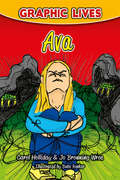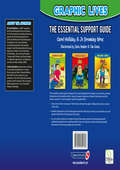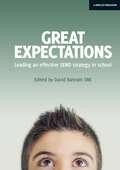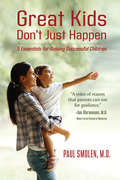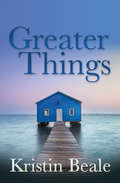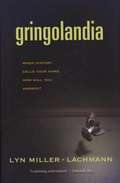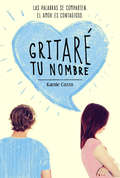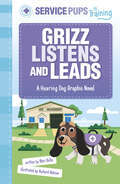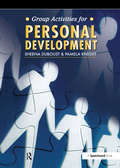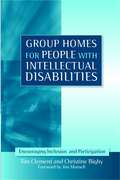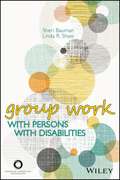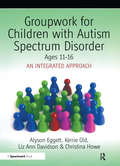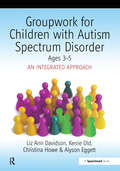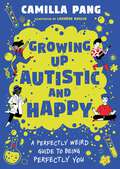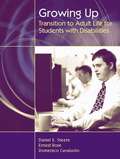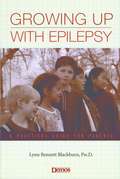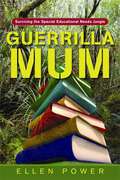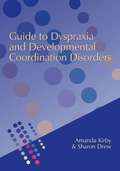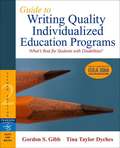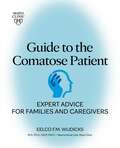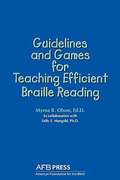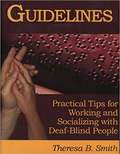- Table View
- List View
Graphic Lives: A Graphic Novel for Young Adults Dealing with an Eating Disorder (Graphic Lives)
by Carol Holliday Jo Browning Wroe Angeleen RenkerGraphic Lives is a series of highly engaging graphic novels for young people who may need counselling and psychotherapy. Each book introduces the difficulties faced by a teenage character and follows them as they travel on their therapeutic journey with a skilled and creative therapist. The key aims of these books are: to demystify counselling and psychotherapy so that it is more appealing and accessible to young people; to destigmatise emotional and mental health problems so that young people are better able to accept help; to encourage young people to embark upon their own healing journeys, equipped with the sense that there is a way forward. Sixteen year-olds Ava and Jade are obsessed with food, calories, and staying thin. Pleased with the many compliments they receive they push themselves into anorexia. Ava's mother is alarmed by her daughter's weight loss and forces her into therapy with the school counsellor, Steph. However after only two sessions Steph touches a raw nerve, Ava storms out and refuses to continue. Only when Jade is admitted to hospital does Ava return to therapy, where she begins to understand the causes of her anorexic tendencies.
Graphic Lives: Essential Support Guide (Graphic Lives)
by Carol Holliday Jo Browning WroeGraphic Lives is a series of highly engaging graphic novels for young people who may need counselling and psychotherapy. Each book introduces the difficulties faced by a teenage character and follows them as they travel on their therapeutic journey with a skilled and creative therapist. The key aims of these books are: to demystify counselling and psychotherapy so that it is more appealing and accessible to young people; to destigmatise emotional and mental health problems so that young people are better able to accept help; to encourage young people to embark upon their own healing journeys, equipped with the sense that there is a way forward. The essential support guide, designed to be used alongside the Graphic Lives novels, provides therapists and counsellors with a range of support resources, linked to the stories and the issues covered. For each graphic novel, this guide offers: clear and concise coverage of risk factors and warning signs relating to the issue covered in the story; detailed exploration of each therapeutic session in the story so that you can devise you own sessions that link to the therapy in the story; an up-to-date summary of research around the issue covered in the book along with professional guidance on working with that issue to help you achieve the best possible outcomes for the young people you work with.
Gray Pancakes and Gold Horses
by Kenneth JerniganHow do blind children learn the details of the hundreds of small daily acts that sighted children pick up without ever even knowing they have done it? A blind boy sits in a farm house on a summer night and wonders which way to shake his head to mean yes and no. He guesses and loses, and his mother's feelings are hurt. I know, for I was that boy.
Great Expectations: Leading An Effective Send Strategy In School
by David BartramA selection of essays from leading educationalists and school leaders with a track record of improving outcomes for children and young people with additional needs, highlighting the significant role that school leaders play in shaping effective practice in SEND. Based on the SEND Review Guide, a national self-evaluation framework part-funded by the DfE and authored by David Bartram and Vijita Patel, downloaded by over 3000 schools, the book is divided into eight sections: Leadership; Teaching and Learning; Working with Pupils and Parents; Identification and Assessment; Monitoring and Tracking; Efficient Use of Resources; Developing Provision; Improving OutcomesEach section includes 3-4 essays. The opening essays offer a broad national perspective on the focus area, authored by a leading educationalist. The following essays, authored by school leaders from a range of educational settings including secondary, primary and special schools, highlight practical examples of how they have improved outcomes for this group of pupils, often in particularly challenging contexts. There will be a strong focus on impact of the approach.
Great Expectations: Leading An Effective Send Strategy In School
by David BartramA selection of essays from leading educationalists and school leaders with a track record of improving outcomes for children and young people with additional needs, highlighting the significant role that school leaders play in shaping effective practice in SEND. Based on the SEND Review Guide, a national self-evaluation framework part-funded by the DfE and authored by David Bartram and Vijita Patel, downloaded by over 3000 schools, the book is divided into eight sections: Leadership; Teaching and Learning; Working with Pupils and Parents; Identification and Assessment; Monitoring and Tracking; Efficient Use of Resources; Developing Provision; Improving OutcomesEach section includes 3-4 essays. The opening essays offer a broad national perspective on the focus area, authored by a leading educationalist. The following essays, authored by school leaders from a range of educational settings including secondary, primary and special schools, highlight practical examples of how they have improved outcomes for this group of pupils, often in particularly challenging contexts. There will be a strong focus on impact of the approach.
Great Kids Don’t Just Happen: 5 Essentials for Raising Successful Children
by Paul SmolenGreat Kids Don’t Just HappenIf there are children in your life, you need Dr. Smolen’s research and wisdom!Physically and emotionally healthy children are Great Kids. They are happier when young and thrive as adults.Pediatrician Dr. Paul Smolen identifies five essential parenting elements which help develop happy and successful kids.In Great Kids Don’t Just Happen you will learn how to use those elements and nurture the children in your life.The author’s observations and advice are supported by scientific studies referenced throughout the book and personal observations from his many years of practice as a pediatrician. The five essential elements and how to apply them are made easy to understand in the warm words of one who knows, practices, and teaches from research, observation, and experience.Learn how to provide:•Realistic praise•Consistent limits•A healthy emotional environment•Strong parental commitment•StabilityDr. Smolen’s research and wisdom are sure to be of great help for your family and loved ones.
Greater Things: Triumph Over Adversity
by Kristin BealeA true story of disability and determination: &“From flat-line to sunshine, this story takes you on an unbelievably heart-crossing journey.&” —Scott Pettit, Double Take At age fourteen, Kristin Beale was enjoying a happy summer vacation when a Jet-Ski accident turned her life upside-down—and nearly ended it. Ever since then, she has had to struggle to overcome not only the physical but the psychological toll of her injuries—and her grit and courage have been an inspiration to countless people. In Greater Things, Kristin offers a raw perspective on everything from how people react to her, to learning how to navigate in and through an inaccessible world, to just trying to make the best of a crummy situation. Filled with honesty, humor, and hope, it&’s a realistic yet ultimately uplifting portrait of what it takes to endure hardship with your spirit intact.
Greff: The Story of a Guide Dog
by Patricia CurtisGreff, a big yellow Labrador retriever, was destined to be a guide dog. Follow Greff from the night of his birth, through his experiences with his puppy raisers, to the time he returns to the Guide Dog Foundation for training, and to the day that Greff and his new owner graduate and go home.
Gringolandia
by Lyn Miller-LachmannDaniel's papá, Marcelo, used to play soccer, dance the cueca, and drive his kids to school in a beat-up green taxi-- all while publishing an underground newspaper that exposed Chile's military regime. After papá's arrest in 1980, Daniel's family fled to the United States. Now Daniel has a new life, playing guitar in a rock band and dating Courtney, a minister's daughter. He hopes to become a US citizen as soon as he turns eighteen. When Daniel's father is released and rejoins his family, they see what five years of prison and torture have done to him. Marcelo is partially paralyzed, haunted by nightmares, and bitter about being exiled to "Gringolandia". Daniel worries that Courtney's scheme to start a bilingual human rights newspaper will rake up papá's past and drive him further into alcohol abuse and self-destruction. Daniel dreams of a real father-son relationship, but he may have to give up everything simply to save his papá's life. This powerful coming-of-age story portrays an immigrant teen's struggle to reach his tortured father and find his place in the world.
Gritaré tu nombre
by Karole CozzoHay amores que se cantan, otros que se susurran, otros que se esconden...,pero también hay amores que hay que gritar muy alto para que el mundo los oiga. «Me di cuenta de lo bien que se acoplaban nuestras manos aquella vez que me dejaste tocarte. Vi que te sentías sola, muy, muy sola. Me pareció lo más absurdo del mundo..., porque hay alguien que está deseando pasar el tiempo contigo. Todos y cada uno de los días de su vida.» En casa, Jordyn siempre ha sido la hermana paciente y comprensiva, haciéndose a un lado mientras el tiempo de sus padres se consume en el cuidado de su hermano, Phillip, que tiene autismo. Ahora Jordyn se ha cambiado a un nuevo instituto y siente que es la oportunidad que estaba esperando para empezar de nuevo: está decidida a ocultar la existencia de su hermano. Pero las mentiras tienen un coste y Jordyn no tarda en darse cuenta de que, si sigue alejando a todo el mundo de su vida paraque no descubran su secreto, podría perderlo todo, incluido a Alex, por quien siente algo muy especial. ¿Encontrará Jordyn el valor para decirle a Alex cómo se siente ycontarle la verdad sobre su familia antes de perderlo para siempre? La crítica ha dicho...«Romance, drama familiar y un final para sentirse bien.»School Library Journal
Grizz Listens and Leads: A Hearing Dog Graphic Novel (Service Pups in Training)
by Mari BolteBasset hounds have long ears, and Grizz is ready to put his to good use. [CS1] He wants to become a hearing dog and help people. But when Grizz is paired with a pompous pup named Luca, he must use his patience and his ears to learn in this early graphic novel.
Group Activities for Personal Development
by Pamela Knight Sheena DuboustAimed at professionals working with groups that are developing social skills and exploring relationships, this photocopiable handbook is a vital collection of workshops covering specific themes. Each theme is clearly divided into warm-ups, main exercises and closures. Intended to help professionals save on preparation time, the organisation and format of this book reflects its highly practical content.
Group Work With Persons With Disabilities
by Sheri Bauman Linda R. ShawThis one-of-a-kind manual provides direction for leading groups of people with disabilities or groups that have members with disabilities. Viewing disability as a single aspect of a multifaceted person, Drs. Bauman and Shaw share their insight and expertise and emphasize practical skill building and training for facilitating task, psychoeducational, counseling, family, and psychotherapy groups across various settings. Topics examined in Part I include common themes in groups that focus on disability; various group formats, including groups using technological platforms; issues of diversity that exist simultaneously with ability; group composition; ethical concerns; and training considerations and logistical accommodations. Part II focuses on group counseling with clients experiencing sensory, psychiatric, cognitive, and physical disabilities as well as chronic medical conditions. A list of resources, support information, and group exercises completes the book. *Requests for digital versions from the ACA can be found on wiley.com. *To request print copies, please visit the ACA website here. *Reproduction requests for material from books published by ACA should be directed to permissions@counseling.org
Groupwork for Children with Autism Spectrum Disorder Ages 11-16: An Integrated Approach
by Christina Howe Alyson Eggett Kerrie Old Liz Ann DavidsonThis book includes a short, easy-to-read theoretical background to ASD focusing on the underlying impairments and their impact on sensory processing, motor development, play, language and communication skills, social skills, emotional development and behaviour for the relevant age group. Each developmental area is intrinsically linked and progress in one aspect of development is dependent on progress in another so a multi-disciplinary approach is essential. All the books examine the role of various individual professionals while emphasising the need to develop a multi-disciplinary approach combining their areas of expertise. The book also describes a multi-disciplinary approach to groupwork providing practical advice and photocopiable resources to enable readers to: assess individual needs; organise groups (including group members, venue and transport); set individual group targets; plan group sessions (examples of activities for each developmental area are provided); and, evaluate progress. It offers ideas for developing good teamwork, including peer review, and working towards a trans-disciplinary approach where professionals can step into each others' roles where appropriate. This title features 256pp, A4, and it is wire-o-bound. It is suitable for children of ages 11-16.
Groupwork with Children Aged 3-5 with Autistic Spectrum Disorder: An Integrated Approach
by Christina Howe Liz Ann Davidson Ayson Eggett"Groupwork for Children with Autism Spectrum Disorder: Ages 3-5" is the first of three books promoting a multidisciplinary approach to working with children on the autism spectrum. The author team of speech & language therapists and occupational therapists have used their experience of working together in this way to create a practical resource for professionals working with children with ASD in small groups. The book aims to develop the children's skills in seven key areas of development: Communication & language; Socialisation; Play; Sensory; Motor; Behaviour; and, Emotional. Case studies, working examples, photocopiable checklists, assessment forms and session sheets are provided for group facilitators to: assess individual needs; set individual targets; create personalised programmes; plan & run group sessions; evaluate progress; and, carry out peer reviews. Forty photocopiable activities, differentiated according to the developmental area being targeted as well as the developmental level of the child, are also included. "Groupwork for Children with Autism Spectrum Disorder: Ages 3-5" provides an invaluable resource for speech & language therapists, occupational therapists, physiotherapists, play therapists, family therapists, teachers, support staff and all those working to develop the children's skills in small groups. Parents and carers are actively encouraged to participate in groupwork with their child. 'I enjoyed joining in the group and being part of my child's therapy'.
Growing Up Autistic and Happy: A Perfectly Weird Guide to Being Perfectly You
by Camilla Pang'I definitely feel better about myself, about being me, after reading this book.' - 11-year-old reader, ToppstaDiscover how scientific concepts can help navigate everyday human interactions, and help you grow up to be your HAPPIEST YOU!As a child, Camilla loved patterns and putting things in order. She was obsessed with Stephen Hawking, and the only language she really understood was science. Diagnosed with autism aged 8, Camilla saw the world very differently.But with science as her sidekick, she was able to translate ideas she could understand, such as photosynthesis and algorithms, onto things she couldn't, such as dealing with emotions and finding your voice. In this unique and brilliant book, Camilla shares her scientific survival guide to growing up, helping young readers navigate the world around them, giving them the courage to grow up perfectly happy in who they are.
Growing Up: Transition to Adult Life for Students with Disabilities
by Daniel E. Steere Ernest Rose Domenico CavaiuoloCase studies of students with mild and severe disabilities are followed throughout the book to illustrate effective practices that are described. Through case studies and clearly presented content, this book helps readers learn what they can do to assist students with disabilities in achieving positive adult outcomes.
Growing up with Epilepsy: A Practical Guide For Parents
by Lynn Bennett BlackburnBlackburn, a pediatric neuropsychologist at St. Louis Children's Hospital, shows parents how to support social development, advocate for a child with epilepsy in the educational system, and provide effective discipline. Early chapters present essential information on understanding epilepsy, behavior management, and school programming. The rest of the book concentrates on developmental stages as they are affected by the effects of epilepsy on social development.
Guerrilla Mum
by Ellen PowerGetting the educational provision you need for your special needs child can feel like an uphill struggle. This book offers clear guidance on how authorities such as Local Education Authorities, schools, the National Health Service and the Government function, what the law entitles your child to, and how you can fight most effectively for the education they need. Basing the book on her own experience of bringing up two sons with special educational needs, Ellen Power describes how she worked with - and in some cases challenged - the authorities to get the right education for her children. Outlining what she did, how she did it, and how you can do the same, she explains clearly the implications of the Special Educational Needs code of practice and the Disability Discrimination Act, as well as giving advice on diagnosis, assessment, and dealing with the authorities. Further sections look at how to address issues such as transition between schools, and bullying. Interweaving real-life experience with practical advice, Guerrilla Mum is essential reading for parents of children with special educational needs and disabilities.
Guide to Dyspraxia and Developmental Coordination Disorders
by Sharon Drew Andrew KirbyBuilt upon the good practice for which the Dyscovery Centre has become so well known, this book takes a broader view of the difficulties that those with additional needs face. It considers whether this is a health, educational or social difficulty and what the wider implications are for the individual and how they manage at home and in the community. The authors look at what happens, what can be done to help and what changes occur as the child becomes an adolescent and eventually an adult. Teachers, SENCOs, teaching assistants, occupational therapists, physiotherapists, speech and language therapists and parents of children with dyspraxia or developmental co-ordination disorders should find this book stimulates their thinking and helps them in their work.
Guide to Writing Quality Individualized Education Programs
by Gordon S. Gibb Tina Taylor DychesThis bestselling guide helps users reduce the complexity of IEP development to seven basic steps, based on the requirements of IDEA 2004. It helps prepare teacher candidates with excellent IEP-writing skills, and gives in-service teachers an accurate resource for their continuing professional development in this critical area. Features include step-by-step instruction for IEP development, using explanation, modeling, practice and formative feedback for self-guided individual or group learning. The introduction of the second edition provides a quick overview of special education and the requirements of IDEA 2004. Additionally, the second edition is based on new case studies with complete IEPs for four elementary and secondary students with mild/moderate and severe disabilities, including transition planning. It also provides practice in differing requirements for students taking alternative assessments and features "Answers to Tricky Questions About IEPs" that teachers often encounter.
Guide to the Comatose Patient: Expert advice for families and caregivers
by Dr. Eelco WijdicksCaring for a loved one in a coma is a distressing time, full of many questions, and often, not as many answers. Guide to a Comatose Patient is a first-of-its-kind book that steps into the shoes of the neurologist, to show the perspective of the staff caring for their loved ones — what worries us, how we think and intervene, what we can and cannot predict, and what we know as a certainty.In our hospital ICUs, there are more than a dozen comatose patients at any given point of time. Causes of coma can range from drug-induced coma—in which medications are used to calm the patient and allow the ventilator to work properly—to coma due to intoxication and coma related to a brain injury. No matter the reason, it can be a distressing time for loved ones. Guide to a Comatose Patient is a helpful guide for any family member or loved one confronted with coma. Author Eelco F. M. Wijdicks, M.D., Ph.D., a leading neurologist and attending neurointensivist at Mayo Clinic, begins each chapter by sharing helpful anecdotes from a career spanning four decades, before diving into the answers to commonly asked questions, such as: · What are the causes of coma? · When will the patient wake up and recover? · When is no recovery expected? · When should we consider organ donation? · What are the rates of survival? While there are many books on families&’ experiences with acute traumatic brain injury and coma, Dr. Wijdicks offers an unusually candid conversation that allows a peek inside the minds of the doctors caring for your loved one. Having had many experiences talking to families having to make difficult decisions at a very difficult time, Dr. Wijdicks&’s message is hopeful while remaining grounded in reality—a reality in which facts must dictate actions. Guide to a Comatose Patient provides important information so that families better understand treatment options, but most importantly, the book offers an open dialogue and optimal transparency to help provide hope and healing through times of grief.
Guidelines and Games for Teaching Efficient Braille Reading
by Sally S. Mangold Myrna R. OlsonThese unique guidelines and games provide ideas for adapting a general reading program to the needs of braille readers and enriching early instruction in braille that are based on research in the areas of rapid reading and precision teaching. Classroom teachers and anyone working with children who are blind or visually impaired will find this classic handbook an invaluable resource.
Guidelines: Practical Tips for Working and Socializing with Deaf-Blind People
by Theresa B. SmithHow does deaf-blindness affect communication? How does one guide a person who is deaf and blind? How does all of this affect the role of the interpreter etc.?
